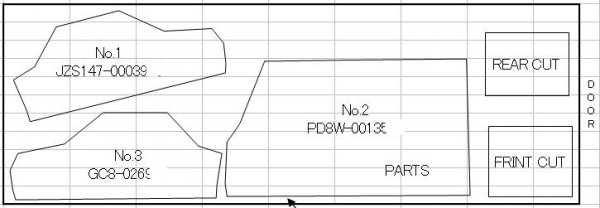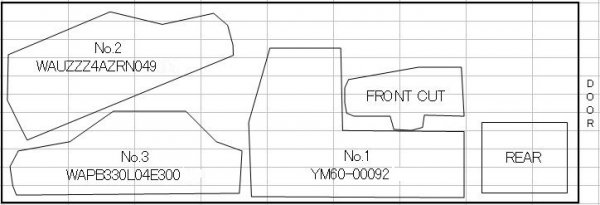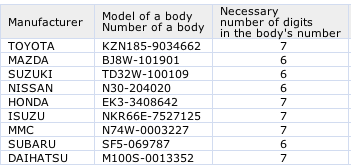Container Packing – Madman’s Tetris
It's pretty common knowledge that cars shipped from Japan didn't drive to their final destination. So, that means the car was shipped somehow.
When shipping cars from Japan, there is a 'stuffing' and 'destuffing' fee, which is a fee to get some one to put your car in, then later take your car out of a shipping container. The fee is a few hundred dollars both times.... now that seems like a lot.... Until you see what the containers look like when it's all said an done.
I took these images from Brave Auto's site (here and here - worth a read!) where they are discussing half cuts (a post on it's own). In short, one of the cars is cut in half in the container. You can see in the images that cars hang from ropes over other cars. This is to utilize all the possible space in the container to bring down the shipping costs per car.
While talking about container shipping cars, Mark at Brave Auto mentioned that it's generally easy to get the cars into the container, but quite difficult to get the cars OUT of the container without damaging them. This surprised me, but after thinking about it.... you're lowering a 2-3 ton car which is hanging dangerously close to other cars.... it's a recipe for disaster! So, Brave auto tries to leave room in the container even though another car could be shoehorned into the container. Doing this lowers the chances that a car is damaged while putting the cars in or taking the cars out.
A tense moment…
Got this in the mail yesterday:
Now, this is tense since MPI is known to call in cars for re-inspection (free of charge!), where they'll re-check all the compliance items that imported cars must adhere to. It's happened to a few of my friends, but I've not been called in yet. So, I was thinking this might be a precursor to it.... luckily it's not. So, what was this for? Well...
A VIN (Vehicle Identification Number) is a North American invention. A VIN is a 17 digit number, with a few different conventions on what the numbers mean.
JDM vehicles ship with a chassis code (or frame number).
As seen here, the codes can be of varying lengths, ranging from 9-12 digits. Also, this is where the chassis number comes from! The model is the first few alphanumeric digits. My Subaru's number is GC8-xxxxxxx, my Hijet was S83P-xxxxxxxx. An 'S13' Silva would be S13-xxxxxxx. Super cool!
There should be a plate on every JDM car listing the model number, chassis code, engine number and transmission number. It's quite informative and interesting to look at. Check it out on your car, or your friend's car!
BC's public insurer (ICBC) provides 17 digit VINs to their customers, while Manitoba's (MPI) doesn't. So, apparently they'll occasionally check in to make sure it's still the same number. Make work project!
Conversation with the Deputy Minister of Infrastructure and Transportation
Here's an update on the world's slowest conversation.
This was my letter to the minister:
Mr McNeil,
First of all, thank you for your thoughtful reply. I appreciate the time you took to respond to my mail. I apologize for the time it has taken me to get back to you.
Though MPI administers the law, the legislature makes the laws. I agree that MPI is a stakeholder and should be an active member in the conversation about changes to any vehicle safety standards, but the changes must take place at a higher level. I have had a meeting with some MPI staff, and they have been very helpful answering my questions and meeting with me, but I feel that these changes are beyond their jurisdiction.
But, the problem as I see it is that Manitoba is falling behind the times in terms of vehicle safety. The world is getting smaller, and it is becoming easier for regular folk to import the cars of their dreams from other countries. I don't see this as a passing fad, and I believe that it should be looked at and handled sooner rather than later.
The most important part of the argument is that it is absurd and archaic that ECE coded (e-coded) lighting is not accepted in Manitoba. This is a world standard that has been accepted in the Motor Vehicle Safety Act (http://www.tc.gc.ca/eng/acts-regulations/regulations-crc-c1038-sch-iv-108.1.htm), and a precedent has been set by allowing vehicles such as Mercedes Benz into the country, as they have no DOT markings, but only ECE markings. Clearly proper e-codes for left-hand drive countries must be marked on the headlights, but all ECE markings should be accepted for non-headlight lighting.
Accepting ECE markings will not make the vehicles less safe, and bring Manitoba up to the world standard for safety.
ICBC, the public insurer for British Columbia has already implemented some of these changes, including accepting JIS (Japanese standards) to the fold. Accepting national standards from other 1st world countries makes sense in this which is getting smaller. I understand that not every vehicle should be permitted on Manitoban roads (the autorickshaw from India comes to mind), but accepting other-national standards for imported cars (15 years or older) makes sense for this ever-shrinking world.
I've attached my full technical document again for your perusal, as I believe it outlines my argument well.
Thank you again for your time.
Robert Guderian
Concise and polite, I'd say.
This is the minister's response:
Dear Mr. Guderian:
I am responding to your January 6, 2012 e-mail regarding your interest in Manitoba's vehicle equipment laws in relation to grey imports. I am pleased that you have found Manitoba Public Insurance (MPI) to be helpful in addressing some of your concerns regarding this matter.
I appreciate your comments affirming that the Manitoba Legislature has jurisdiction over the creation and amendment of provincial statutes. In doing so, guidance and advice is sought from various stakeholders. Stakeholder recommendations are taken into consideration; however, as you rightly stated in your correspondence, the decision for legislative or regulatory changes ultimately lies with Government.
Manitoba Public Insurance has been requested by the Government of Manitoba to review Manitoba's equipment standards in relation to grey imports. Manitoba Public Insurance is in the process of reviewing the European and Japanese vehicle lighting standards and will inform Manitoba Infrastructure and Transportation of their findings and recommendations regarding this matter. Please be assured that MPI's assistance with this does not preclude consideration being given to information provided by other equally valuable sources. Manitoba Infrastructure and Transportation is currently examining all of Manitoba's vehicle equipment requirements with a view to ensuring that they are current. The information you provided will be given full consideration in the overall review of these standards. Your patience while the review is being conducted is greatly appreciated.
I hope you find this information helpful.
Sincerely,
Doug McNeil, M. Eng., P. Eng.
Deputy Minister of Manitoba Infrastructure and Transportationc. Honourable Steve Ashton
Honourable Andrew Swan
Mr. Ward Keith
It's a nice way of saying, "Yes, you're right, now bugger off". At first they say "Go talk to MPI, they'll help you". So, I point out that MPI is no the person I want to talk to, I want to talk to the people making the changes... to which they say, "Yeah, you're right, that's us!".
I'm not sure how to approach this now. My plan is to point out that JIS parts are better than DOT, and Australia has already done this work for us. And, want to raise the issue of seatbelts too, but I also want to stay focused on one topic. Really, too much to do and too little time.
Thoughts, anyone?
Rob



